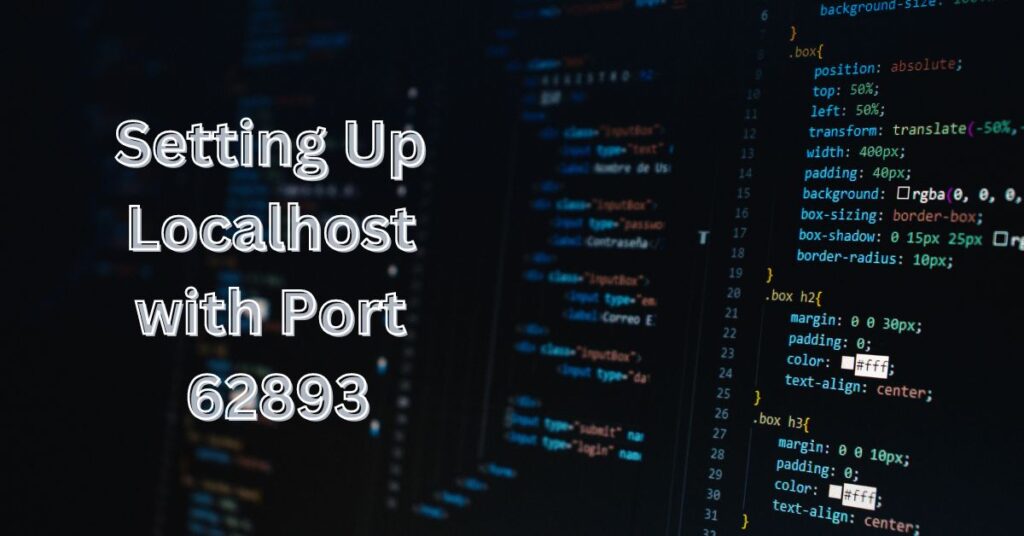127.0.0.1:62893 is a combination of the loopback IP address (127.0.0.1) and a specific port number (62893) used in networking and local development. This address-port pair allows developers to test applications on their own machines without affecting live servers or external networks.
Imagine having a secret laboratory right in your computer where you can experiment with new ideas, test wild theories, and perfect your creations before showing them to the world. That’s exactly what 127.0.0.1:62893 offers to developers and tech enthusiasts alike.
By understanding and utilizing 127.0.0.1:62893, you can unlock a whole new level of efficiency in your development process, ensuring your applications are robust and bug-free before they ever see the light of day.
The Basics of IP Addresses and Ports
Ever wondered how your computer finds its way around the internet? Well, it’s all thanks to IP addresses and ports. Think of them as the street addresses and apartment numbers of the digital world. They’re the unsung heroes that make sure your cat videos and emails end up exactly where they should.
IP Address:
An IP address, or Internet Protocol address, is a unique numerical identifier assigned to each device connected to a computer network that uses the Internet Protocol for communication.
It serves two main purposes:
- Identifying the host or network interface and providing the location of the device in the network.
- IP addresses come in two versions: IPv4, which uses 32-bit numbers, and IPv6, which uses 128-bit numbers to accommodate the growing number of devices connected to the internet.
Ports:
Ports in computing are virtual endpoints for communication between devices or applications over a network. They are identified by numerical values and facilitate the exchange of data between different processes or services running on networked systems.
Here are the common protocols and their specific port numbers in bullet points:
- HTTP (Hypertext Transfer Protocol): Port 80
- HTTPS (HTTP Secure): Port 443
- FTP (File Transfer Protocol): Port 21 (control), Port 20 (data transfer)
- SSH (Secure Shell): Port 22
- SMTP (Simple Mail Transfer Protocol): Port 25
- POP3 (Post Office Protocol version 3): Port 110
What is an IP Address?

An IP address is like your computer’s phone number on the internet. It’s a string of numbers (like 192.168.1.1) that identifies your device on a network. Without it, the internet would be like a postal service without addresses – chaotic and useless.
Every device connected to the internet needs an IP address to communicate. It’s how websites know where to send the information you’ve requested, and how your friend’s computer knows where to send that hilarious meme.
IP addresses come in two flavors:
- IPv4 (the older, more common type)
- IPv6 (the newer,, bigger type)
Understanding Port Numbers
If IP addresses are like phone numbers, think of port numbers as extensions in a big office. They help direct different types of internet traffic to the right applications on your computer. Without ports, your computer would be like a receptionist trying to handle all calls on a single line – it’d be mayhem!
Port numbers range from 0 to 65535, but don’t worry, you don’t need to memorize them all. Some ports are like VIPs – they’re reserved for specific purposes.
For example, web traffic usually goes through port 80, while secure web traffic uses port 443. It’s like having dedicated lanes for different types of vehicles on a highway.
Read this article: What are the Best Practices for Integrating AI into Smart Contract Auditing Processes?
Localhost: Your Computer’s Inner Sanctum

- Localhost is your computer’s private clubhouse
- It’s a way for your machine to communicate with itself (like an internal monologue)
- Localhost is represented by the IP address 127.0.0.1
- Using localhost tells your computer to run a program locally, not for the entire internet
- It’s particularly useful for developers and tinkerers
- Allows testing of web applications, databases, and network-based programs
- Provides a private sandbox environment for building and experimenting
The Magic of 127.0.0.1:62893
127.0.0.1:62893 might look like a secret code, but it’s actually a powerful tool for developers. The first part, 127.0.0.1, is the localhost IP address we just talked about. The :62893 part is just a specific port number.
Together, they create a unique address on your computer where an application can live and work. Using this combination allows developers to run multiple applications on their machine without them interfering with each other.
It’s like giving each application its own room in the localhost house. This is super useful when you’re working on complex projects that involve multiple components all talking to each other.
The beauty of 127.0.0.1:62893 is its flexibility. While 62893 is just an example, you can use pretty much any port number in its place (as long as it’s not already in use). This gives developers the freedom to set up their local environment exactly how they need it, making the development process smoother and more efficient..
Setting Up Local Host with Port 62893

Steps for setting up local host with the port 62893 are
- Install necessary software:
- Web server (e.g., Apache, Nginx)
- Database (e.g., MySQL, PostgreSQL)
- Development frameworks or languages (e.g., PHP, Python, Node.js)
- Configure the web server:
- Set it to listen on 127.0.0.1 (localhost)
- Configure it to use port 62893
- Set up the database:
- Create a local database
- Configure it to run on localhost
- Install and configure any required development frameworks
- Set up your project files in the appropriate directory
- Configure your application to connect to the local database
- Start your web server and database services
- Test your setup by accessing http://127.0.0.1:62893 in a web browser
- Begin developing and testing your application in this local environment
Top 5 Uses of 127.0.0.1:62893 in Development
- Local web server testing
- API development and debugging
- Database server setup
- Microservices architecture testing
- Network protocol simulation
Common Issues with Solutions

| Issue | Cause | Solution |
| Port already in use | Another application is using port 62893 | Change to a different port number |
| Connection refused | Application not running or misconfigured | Check application status and configuration |
| Access denied | Insufficient permissions | Run with administrative rights |
| Firewall blocking | Firewall settings preventing access | Allow access through firewall settings |
| Cannot bind to address | IP address not available on the system | Verify network configuration |
Final Words
In the world of web development and networking, 127.0.0.1:62893 is more than just a string of numbers – it’s a gateway to efficient, secure local testing. This combination of the localhost IP address and a specific port number provides developers with a powerful tool for creating and refining applications.
By offering a controlled environment right on your own machine, it enables thorough testing and debugging without the risks associated with live systems.The beauty of 127.0.0.1:62893 lies in its simplicity and versatility.
Whether you’re a seasoned professional or a coding newcomer, this local address can significantly streamline your development process. It allows for rapid iteration, easy troubleshooting, and the confidence that comes from knowing your application works flawlessly in a controlled setting before deployment.
Frequently Asked Questions
What’s 127.0.0.1 all about?
127.0.0.1 is the loopback IP address that allows a device to communicate with itself, commonly used for local testing and development.
Why use port 62893?
Port 62893 is just an example; any available port in the dynamic range can be used for local development.
Can I use a different port with 127.0.0.1?
Yes, you can use any available port number with 127.0.0.1 for local development.
How do I know if port 62893 is free to use?
You can check if port 62893 is available using network utility tools like ‘netstat’ or ‘lsof’ on your system.
Is it safe to use 127.0.0.1:62893?
Yes, it’s safe for local development, but always ensure your computer’s overall security.








